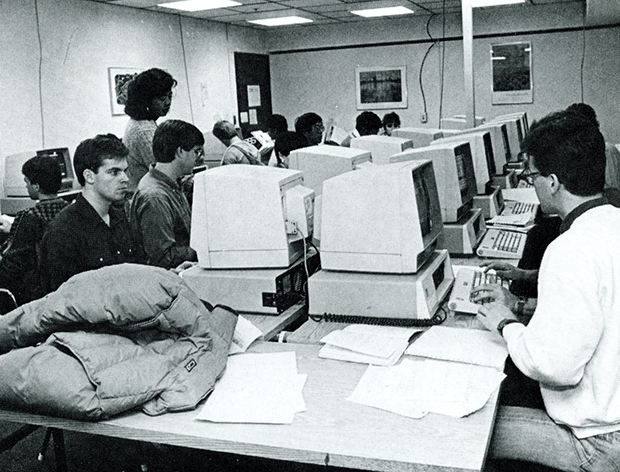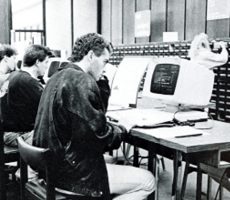- November 24, 2015
- By Chris Carroll
Every time you open a Web page or an email, you’re treading Internet pathways blazed in part by Glenn Ricart Ph.D ‘80, former head of academic computing and networking at the University of Maryland.
 Under Ricart, who took over the Computer Science Center in 1982, UMD became the first campus in the world to be fully connected by Internet protocols. Soon after, he linked Maryland with other universities in the first regional academic computer network. Then in 1988, he established the world’s first Internet exchange point in College Park—a bridge between existing commercial, government and academic computer networks that helped birth the global Internet we know today.
Under Ricart, who took over the Computer Science Center in 1982, UMD became the first campus in the world to be fully connected by Internet protocols. Soon after, he linked Maryland with other universities in the first regional academic computer network. Then in 1988, he established the world’s first Internet exchange point in College Park—a bridge between existing commercial, government and academic computer networks that helped birth the global Internet we know today.
Ricart moved on in 1993, working as a project manager at the Defense Advanced Research Projects Agency before joining the computing industry. But it was his firsts at UMD that earned him entry into the Internet Hall of Fame in 2013. After a recent lunch in his honor with university leaders, he spoke about Maryland’s place in Internet history. The interview has been edited for length.
TERP: What was the state of computing on campus in the early 1980s?
Ricart: When I came in, I was in charge of a big mainframe computer. We had trucks that went out and delivered printouts and picked up card decks twice a day. I knew even in 1982 this was not the future of computing. The departments, recognizing that the mainframe was not what they wanted to rely on, were buying their own minicomputers and doing their own computing. They were saying, “We don’t need anything from Glenn’s organization.” I said to myself, “Hmm, I seem to be king of a dinosaur.”
TERP: What were your options?
Ricart: What I really wanted to do was provide a way for all the computers on campus to communicate with each other. During my honeymoon period as the new interim director of the Computer Science Center, I asked all the other folks on campus, “Would you please install this Internet software on your computers so they can talk to a new campus-wide network?” We used some available coax cable to build an automation system and connected up all the computers on campus into a campus network. That was the first time anyone had done that anywhere.
TERP: Did everyone love it?
Ricart: It turns out the chemistry department does not have that much to say to the business school, and the philosophy department does not communicate that much with meteorology. So my first big initiative here at College Park was a colossal failure. I wondered how I could make lemonade out of these lemons, and came up with a two-part strategy.
Part one was to convince several other universities to make the same colossal mistake, because then each of their chemistry departments could talk to other chemistry departments. That became SURAnet (Southeastern Universities Research Association Network), and I got a National Science Foundation grant to go and connect one campus in each of 18 states and the District of Columbia to Maryland and to each other. They began to share data; they began to share preprints of papers; they began to collaborate and submit jointly to funding agencies. It worked.
TERP: How did the network change the campus?
Ricart: That was the second part of the strategy. In the Main Administration Building, about a dozen students would sit throughout the business day in case something needed to be distributed across campus. A secretary would type it up on a ditto master and run it off on the ditto machine, and then you’d hand copies to the students who’d fan out and deliver them to the deans’ offices.
I said, “We could do better than that, now that we have all these computers hooked up. We could arrange for something to be automatically printed in every dean’s office by sending it electronically.” So in those days, anytime something came off the printer in the dean’s office, everyone ran to it to see what it was, because it had to be important—it had come from the Main Administration Building!

TERP: The network also helped create the email culture we have today.
Ricart: Brit Kirwan, the provost at that time, said, “I’d like to get your budget submissions using electronic mail,” and suddenly every dean was using electronic mail. Then the deans, seeing how well this worked, began asking their department chairs to use this new method of communication, and so the network became useful for binding the campus together. It did put a dozen students out of work, but nevertheless that was something it really made a difference to the campus.
TERP: What was your role in the global Internet essentially taking off on this campus?
Ricart: The Internet protocols were invented in the early ‘70s, and a few organizations had created their own individual networks using the protocols. But these networks were all islands—they didn’t talk to one another. The protocols were capable of connecting, but at the time the thinking was that if NASA is sponsoring a network, NASA doesn’t want to pay to carry traffic from DOD, and DOD doesn’t want to pay to carry traffic from NASA, etc.
TERP: How did you connect the islands?
Ricart: At the University of Maryland, we were already connected to a number of these other networks through individual academic departments. I said, “Why don’t we take advantage of the fact that these Internet protocols allow you to go from one network to another to make a true Internet?” There wasn’t any real Internet before that time—with an emphasis on “inter.” I asked the other network administrators, “If something arrives at the University of Maryland addressed to somebody on a different network, can I actually just hand it off to that other network?” But no one could give me permission. So I reversed the question: “Would you have any objection if I did that?” They said, “As long as you don’t quote me, why don’t you try it?”
TERP: So you were the first to interconnect the pieces of the “capital-I” Internet.
Ricart: We did. We began acting as the central routing point for all of these islands, and people loved it. Everyone was now on what was a single, common and growing Internet. The interchange point for all that traffic was right here at the University of Maryland because I had volunteered to take everyone’s traffic from all these islands and switch it to anybody else who wanted it.
TERP: The actual facility ended up being up the street, right?
Ricart: Yes, the vice president for administrative affairs at the time asked me to take it off campus. He was worried that some students might be upset about a Department of Defense connection. So we rented the building at 8404 Baltimore Ave. and moved the interconnection point there. That really was the center of the Internet for the next couple of years.
